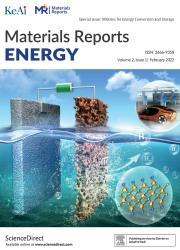Investigation of internal action to enhance structural stability and electrochemical performance of K+/Mg2+ co-doped cathodes in high voltage environments utilizing dual coordination
IF 13.8
引用次数: 0
Abstract
Sodium-ion batteries (SIBs) are emerging as a promising alternative for large-scale energy storage, particularly in grid applications. Within the array of potential cathode materials, Fe/Mn-based layered oxides are notable for their advantageous theoretical specific capacity, economic viability, and environmental sustainability. Nevertheless, the practical application of Fe/Mn-based layered oxides is constrained by their suboptimal cycle performance and rate capability during actual charging and discharging. Ion doping is an effective approach for addressing the aforementioned issues. In this context, we have successfully developed a novel K+ and Mg2+ co-doped P2-Na0.7Fe0.5Mn0.5O2 cathode to address these challenges. By doping with 0.05 K+ and 0.2 Mg2+, the cathode demonstrated excellent cycling stability, retaining 95% of its capacity after 50 cycles at 0.2C, whereas the undoped material retained only 59.7%. Even within a wider voltage range, the co-doped cathode retained 88% of its capacity after 100 cycles at 1C. This work integrated Mg2+ to activate oxygen redox reactions in Fe/Mn-based layered cathodes, thereby promoting a reversible hybrid redox process involving both anions and cations. Building on the Mg doping, larger K+ ions were introduced into the edge-sharing Na+ sites, enhancing the material's cyclic stability and expanding the interplanar distance. The significant improvement of Na+ diffusion coefficient by K+/Mg2+ co-doping has been further confirmed via the galvanostatic intermittent titration technique (GITT). The study emphasizes the importance of co-doping with different coordination environments in future material design, aiming to achieve high operating voltage and energy density.

利用双配位提高高压环境下K+/Mg2+共掺杂阴极结构稳定性和电化学性能的内部作用研究
钠离子电池(sib)正在成为大规模能源存储的一种有前途的替代方案,特别是在电网应用中。在一系列潜在的正极材料中,铁/锰基层状氧化物以其优越的理论比容量、经济可行性和环境可持续性而闻名。然而,铁/锰基层状氧化物的实际应用受到其在实际充放电过程中的次优循环性能和倍率能力的限制。离子掺杂是解决上述问题的有效途径。在此背景下,我们成功开发了一种新的K+和Mg2+共掺杂的P2-Na0.7Fe0.5Mn0.5O2阴极来解决这些挑战。当掺杂0.05 K+和0.2 Mg2+时,阴极表现出了良好的循环稳定性,在0.2 c下循环50次后,阴极的容量保留了95%,而未掺杂的材料仅保留了59.7%。即使在更宽的电压范围内,共掺杂阴极在1C下循环100次后仍能保持88%的容量。本研究将Mg2+集成到Fe/ mn基层状阴极中,激活氧氧化还原反应,从而促进阴离子和阳离子的可逆混合氧化还原过程。在Mg掺杂的基础上,更大的K+离子被引入到共用边的Na+位点,增强了材料的循环稳定性,扩大了材料的面间距离。通过恒流间歇滴定技术(git)进一步证实了K+/Mg2+共掺杂对Na+扩散系数的显著改善。该研究强调了不同配位环境的共掺杂在未来材料设计中的重要性,旨在实现高工作电压和能量密度。
本文章由计算机程序翻译,如有差异,请以英文原文为准。
求助全文
约1分钟内获得全文
求助全文
来源期刊

材料导报:能源(英文)
Renewable Energy, Sustainability and the Environment, Nanotechnology
CiteScore
13.00
自引率
0.00%
发文量
0
审稿时长
50 days
 求助内容:
求助内容: 应助结果提醒方式:
应助结果提醒方式:


